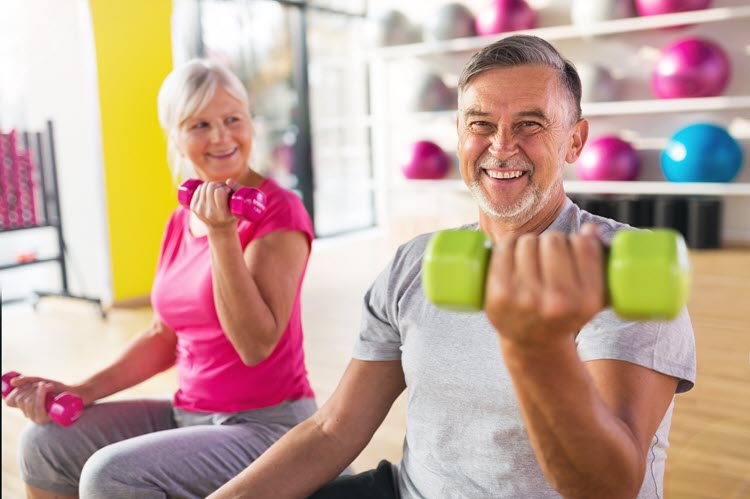Everyone benefits from physical movement, and the older we get, the more we need to exercise to stay fit and active.1 The best exercises for seniors – and those to avoid – range from a general physical activity such as walking to more deliberate moves for targeted muscle groups such as bicep curls. Whether you’re new to physical fitness or have been around the athletic block, check with your physician or trusted healthcare provider before you begin any type of exercise routine.
Exercises to Include for Seniors
From low-impact cardio to focused strength training, the best exercises for seniors include all types of activities, such as group dog walks, ballroom dancing, riding an exercise bike, yoga or Pilates, weight lifting and resistance training, and even the neighborhood pick-up basketball game.
Cardio
Walking is one of the best exercises anyone can do. 2 Begin slow and take a stroll around your neighborhood. Join a group dog walk and make new friends along your exercise journey. Work your way up to trail walking by a stream or a brisk hike through the nearest park. Other low- to moderate-intensity cardio exercises good for seniors include:
- Jogging
- Dancing
- Hiking
- Cycling
- Swimming
- Water Sports
- Basketball
- Tennis
- Pickleball
Water Aerobics
A popular exercise for seniors that keeps pressure off the joints, water aerobics provides those with arthritis or other joint mobility issues a chance to safely gain strength through natural resistance with the water. Often using deliberate moves and actions, water aerobics allows seniors to focus on certain muscles, increase flexibility, and practice balance. Different water exercises for seniors include:
- Leg lifts
- Arm curls
- Walking or jogging
- Swimming
- Wall push-ups
Resistance Training
Resistance training involves using your own body weight, rubber bands, or a stationary machine to create a resistance to your physical action. Common, popular, and recommended body-weight resistance training exercises for seniors include push-ups, dips, calf raises, and squats. Resistance-band workouts include exercises such as the bicep curl, lateral raise, and leg press. Stationary machines, without added weights, include the lateral pulldown, standing row, and bicep curl.
Weight Training
Lifting weights increases strength, bone density, and overall well-being. It also benefits those with diabetes, osteoporosis, depression, and obesity.34 Strength training exercises target the muscle groups in your arms, legs, and torso for an overall body workout. If you’re new to lifting weights, start low and slow until you can work your way up to heavier weights and more demanding lifts. Weight training exercises for seniors include using both weight machines and free weights – bicep curls, tricep extensions, lateral raises, and overhead press.
Balance and Core Strengthening
Most exercises for seniors automatically work on the core – the area between the shoulder blades and hips. Our core is what allows us to bend, twist, turn, and balance. Focusing solely on your back and stomach muscles aids in building a stronger spine and creating better posture.5 Strengthening your core happens during activities such as yoga, Pilates, stretching, Tai Chi, and ballet, but other notable core strengthening exercises for seniors include:
- Bridges – Lie on your back with your arms by your sides, knees bent, and feet flat on the floor. Gently lift your butt and hips off the floor and hold.
- Planks – Think stationary push-up in the ‘up’ position. A modified version of the plank or push-up uses your hands or forearms and knees to brace yourself in order to keep your back straight.
- Chair yoga – Perform yoga moves while sitting on a chair, which lessens stress on the joints and decreases risk of injury. If you’re unfamiliar with yoga, basic core work such as side bends, knee lifts, and side twists make good exercises for seniors with less mobility.
- Bar stretching – If you have access to a waist-high bar (a sturdy chair back can be used in a pinch), hold on with one hand while practicing basic ballet, yoga, or stretches. From simple maneuvers like pointing and flexing your toes to advanced forms such as arabesque.
Grip Strengthening
We often take our grip for granted, at least until arthritis sets in. Help prevent lost muscle and strength in your hands and forearms doing grip exercises for seniors. From basic grip strengthening – holding and carrying items, such as books, in your hands in finger-grip form – to building forearm muscle – either using free weights or hand grips – creating a stronger grip aids you in performing daily actions such as twisting or gripping doorknobs, carrying or holding dishes, washing laundry, vacuuming, opening jars, and more.
4 Exercises Seniors Should Avoid
If you’re a natural fitness buff, you’re probably already aware of what your body should and should not do. But if you’re new to exercises for seniors and over the age of 65, avoid the following activities unless you are working closely with a doctor or fitness trainer.
- High-impact or high-intensity – Unless you’re accustomed to high-impact or high-intensity exercises, such as long-distance running or high-intensity interval training, this type of exercise could be too much pressure on your joints.
- Deadlift – Skip the deadlift unless you’ve been lifting weights for some time or you’re under the supervision of a certified trainer. Deadlifts rely heavily on your back and knees. If you’ve never properly exercised your core or thighs, a deadlift done incorrectly could injure you.
- Bench or leg press – A bench or leg press can place too much pressure on your elbow and knee joints, possibly causing hyperextension of your limbs. Check with a personal trainer and your doctor to determine if this type of exercise is right for you.6
- Crunches – Though sit-ups and crunches have been performed for decades to strengthen the core, they’re not recommended for anyone. Traditional sit-ups and crunches put a large amount of stress on the neck muscles and aren’t very effective at strengthening the core muscles.7
The best exercises for seniors are geared toward those who may already have issues with mobility, joint pain, disease, or are new to the exercise world. Start your new exercise routine slowly and build up to heavier weights, longer walks, or faster dancing. Consult with your doctor if you experience any concerning health problems while exercising.
Article Sources
Safe Smart Family uses only high-quality sources, including peer-reviewed studies, to support the facts within our articles. Read our editorial process to learn more about how we fact-check and keep our content accurate, reliable, and trustworthy.
- How Older Adults Can Get Started with Exercises. Nia.nih.gov. Accessed May 15, 2022
- 7 Best Exercises for Seniors (and a Few to Avoid!) Seniorlifestyle.com. Accessed May 15, 2022
- Exercise and Seniors. Familydoctor.org. Updated May 2022. Accessed May 15, 2022
- 7 Best Exercises for Seniors (and a Few to Avoid!) Seniorlifestyle.com. Accessed May 15, 2022
- The Best Core Exercises for Older Adults. Health.harvard.edu. Published April 1, 2021. Accessed May 15, 2022
- The Best and Worst Resistance Training Exercises for Seniors. Seniordirectory.com. Accessed May 15, 2022
- The Best Core Exercises for Older Adults. Health.harvard.edu. Published April 1, 2021. Accessed May 15, 2022


